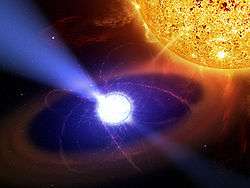AE Aquarii
AE Aquarii is a cataclysmic variable binary star of the DQ Herculis type. Based upon parallax measurements, the system is located at a distance of about 280 light-years (86 parsecs) from the Earth.[1] Because of its unique properties, this system has been subject to a number of scientific studies.[3]
 Artistic illustration of the AE Aquarii system | |
| Observation data Epoch J2000.0 Equinox J2000.0 | |
|---|---|
| Constellation | Aquarius |
| Right ascension | 20h 40m 09.16206s[1] |
| Declination | −00° 52′ 15.0618″[1] |
| Apparent magnitude (V) | 11.6[2] |
| Characteristics | |
| Spectral type | White dwarf + K4–5 V[3] |
| B−V color index | −1.2[2] |
| Variable type | DQ Her |
| Astrometry | |
| Radial velocity (Rv) | −53[4] km/s |
| Proper motion (μ) | RA: +73.95[1] mas/yr Dec.: +12.40[1] mas/yr |
| Parallax (π) | 11.61 ± 2.72[1] mas |
| Distance | approx. 280 ly (approx. 90 pc) |
| Absolute magnitude (MV) | ~6.6[5] |
| Orbit[6] | |
| Period (P) | 9.88 hours |
| Semi-major axis (a) | 2.34 ± 0.02 R☉ |
| Inclination (i) | 70 ± 3° |
| Details | |
| A | |
| Mass | 0.63 ± 0.05[6] M☉ |
| Radius | 0.01[7] R☉ |
| Rotation | 33.08 sec[8] |
| B | |
| Mass | 0.37 ± 0.04[6] M☉ |
| Radius | 0.79[6] R☉ |
| Other designations | |
| Database references | |
| SIMBAD | data |
The AE Aquarii system consisting of an ordinary star in a close orbit around a magnetic white dwarf; the pair orbit each other with a period of 9.88 hours. The white dwarf primary has 63% of the Sun's mass but a radius of only about 1% of the Sun. As of 2009, it has the shortest known spin period of any white dwarf, completing a full revolution every 33.08 seconds. This spin is decreasing at a rate of 1.78 ns per year, which is unusually high.[3] The secondary star has a stellar classification of K4-5 V, making it a main sequence star that is generating energy at its core through the thermonuclear fusion of hydrogen. It has about 37% of the Sun's mass but 79% of the Sun's radius.
This system displays flare activity that has been observed across multiple bands of the electromagnetic spectrum, including X-rays. Mass is being lost from the secondary star, most of which is being flung out of the system by the rapidly spinning magnetic primary. The X-ray luminosity is likely being caused by the accretion of mass onto the white dwarf, which is occurring at an estimated rate of about 7.3 × 1010 kg per second.[3]
See also
References
- van Leeuwen, F. (November 2007). "Validation of the new Hipparcos reduction". Astronomy and Astrophysics. 474 (2): 653–664. arXiv:0708.1752. Bibcode:2007A&A...474..653V. doi:10.1051/0004-6361:20078357.
- "V* AE Aqr". SIMBAD. Centre de données astronomiques de Strasbourg. Retrieved July 22, 2008.
- Mauche, Christopher W. (November 2009), "Chandra High-Energy Transmission Grating Spectrum of AE Aquarii", The Astrophysical Journal, 706 (1): 130–141, arXiv:0910.0084, Bibcode:2009ApJ...706..130M, doi:10.1088/0004-637X/706/1/130
- Evans, D. S. (June 20–24, 1966). Batten, Alan Henry; Heard, John Frederick (eds.). "The Revision of the General Catalogue of Radial Velocities". Determination of Radial Velocities and their Applications, Proceedings from IAU Symposium. University of Toronto: International Astronomical Union. 30: 57. Bibcode:1967IAUS...30...57E.
- From apparent magnitude and parallax.
- Echevarría, J.; et al. (July 2008). "High-dispersion absorption-line spectroscopy of AE Aqr". Monthly Notices of the Royal Astronomical Society. 387 (4): 1563–1574. arXiv:0804.0291. Bibcode:2008MNRAS.387.1563E. doi:10.1111/j.1365-2966.2008.13248.x.
- Itoh, Kei; et al. (2005). "Density diagnostics of the hot plasma in AE Aquarii with XMM-NEWTON" (PDF). Proceedings of 'The X-ray Universe 2005', El Escorial, Madrid, Spain. 639: 1–6. arXiv:astro-ph/0412559. Bibcode:2006ApJ...639..397I. doi:10.1086/499152.
- Patterson, Joseph (December 15, 1979). "Rapid oscillations in cataclysmic variables. III. An oblique rotator in AE Aquarii". Astrophysical Journal. 234: 1–992. Bibcode:1979ApJ...234..978P. doi:10.1086/157582.
External links
- Image AE Aquarii
- (in Portuguese) www.estadao.com.br